Implementation of the Bio-Inspired Metaheuristic Firefly Algorithm (FA) Applied to Maximum Power Point Tracking of Photovoltaic Systems
Abstract
:1. Introduction
2. Algorithm MPPT-P&O and MPPT-FA
2.1. MPPT-P&O Optmization Method
2.2. MPPT-FA Optmization Method
2.2.1. Development of the Method
2.2.2. Light Intensity and Attractiveness
2.2.3. Parameters
- Fireflies will be attracted to each other no matter their sexuality, making attractiveness wider and more effective.
- Firefly that has a light with intense brightness, will have a greater attractiveness, however, the emitted brightness will decrease according to the increase of the distance between the fireflies, due to the absorption factor by the medium.
- The intensity of a firefly’s glow varies according to its objective function, with a brighter glow the better the function value.
2.2.4. Application of the Algorithm in Tracking the Maximum Power Point
2.3. PV System Model
3. Results and Discussion
- A. Step 1—Even distribution of solar radiation
- Simulation—Step 1
- B. Step 2—Partial shading (two power peaks)
- Simulation—Step 2
- C. Step 3—Partial shading (three power peaks)
- Simulation—Step 3
4. Conclusions
5. Discussion
- Use other high-gain DC-DC converter topologies to to evaluate the proposed MPPT-FA method;
- Carry out a comparison with other bioinspired MPPT methods;
- Test other parameters of the PSO algorithm in order to improve the dynamic performance of the proposed method.
Author Contributions
Funding
Institutional Review Board Statement
Informed Consent Statement
Data Availability Statement
Acknowledgments
Conflicts of Interest
References
- Oliveira, F. Rastreamento da Máxima Potência em Arranjos Fotovoltaicos sob Efeito de Sombreamento Parcial Baseado no Método de Otimização por Enxame de Partículas. Master’s Thesis, Universidade Tecnológica Federal do Paraná, Curitiba, Brazil, 2015. [Google Scholar]
- Crepaldi, J.; Amoroso, M.; Ando, O. Analysis of the topologies of power filters applied in distributed generation units-Review. IEEE Lat. Am. Trans. 2018, 16, 1892–1897. [Google Scholar] [CrossRef]
- Maciel, J.; Ledesma, J.; Junior, O. Forecasting Solar Power Output Generation: A Systematic Review with the Proknow-C. IEEE Lat. Am. Trans. 2021, 19, 612–624. [Google Scholar] [CrossRef]
- Junior, O.; Bretas, A.; Leborgne, R. Methodology for calculation and management for indicators of power quality energy. IEEE Lat. Am. Trans. 2015, 13, 2217–2224. [Google Scholar] [CrossRef]
- Emery, K.; Hishikawa, Y.; Warta, W. Solar cell efficiency tables (Version 39). Prog. Photovolt. Res. Appl. 2012, 20, 346–352. [Google Scholar]
- Ishaque, K.; Salam, Z. A review of maximum power point tracking techniques of PV system for uniform insolation and partial shading condition. Renew. Sustain. Energy Rev. 2013, 19, 475–488. [Google Scholar] [CrossRef]
- Rocha, M.; Sampaio, L.; Silva, S. Maximum power point extraction in PV array under partial shading conditions using GWO-assisted beta method. Renew. Energy Power Qual. J. 2018, 1, 450–455. [Google Scholar] [CrossRef]
- Seguel, J. Projeto de um Sistema Fotovoltaico Autônomo de Suprimento de Energia Usando Técnica MPPT e Controle Digital. Master’s Thesis, Universidade Federal de Minas Gerais, Horizonte, Brazil, 2009. [Google Scholar]
- Rocha, N.; Brighenti, L.; Passos, J.; Martins, D. Photovoltaic Cell Cooling as a Facilitator for MPPT. IEEE Lat. Am. Trans. 2019, 17, 1569–1577. [Google Scholar] [CrossRef]
- Spaduto, R.; Freitas, L. Estudo de técnicas de MPPT em sistemas fotovoltaicos. In Proceedings of the Conferência De Estudo Em Engenharia Elétrica, XI, Uberlândia, Brazil, 2013. [Google Scholar]
- Oliveira, F.; Silva, S.; Durand, F.; Sampaio, L.; Bacon, V.; Campanhol, L. Grid-tied photovoltaic system based on PSO MPPT technique with active power line conditioning. IET Power Electron. 2016, 9, 1180–1191. [Google Scholar] [CrossRef]
- Walker, L. Sistemas Fotovoltaicos de Geração Distribuída de Único e Dois Estágios em Conexão com a Rede de Distribuição de Energia Elétrica. Bachelor’s Thesis, Universidade Tecnológica Federal do Paraná, Curitiba, Brazil, 2016. [Google Scholar]
- Figueiredo, S.; Silva, R. Hybrid MPPT Technique PSO-P&O Applied to Photovoltaic Systems under Uniform and Partial Shading Conditions. IEEE Lat. Am. Trans. 2021, 19, 1610–1617. [Google Scholar]
- Brito, M. Inversores Integrados Monofásicos e Trifásicos para Aplicações Fotovoltaicas: Técnicas para Obtenção de MPPT, Detecção e Proteção de Ilhamento, Sincronização e Paralelismo com a Rede de Distribuição de Energia Elétrica. Ph.D. Thesis, Universidade Estadual Paulista (UNESP), Sao Paulo, Brazil, 2013. [Google Scholar]
- Mendonça, B.; Rocha, O.A.T.; Ribeiro, R.; Costa, F. Algoritmo MPPT P&O com Perturbação Variável Aplicado a um Sistema de Geração PV Conectado à Rede Elétrica Trifásica. In Proceedings of the SEPOC 2019: 12th Seminar on Power Electronics and Control, Natal, Brazil, 27 October 2019. [Google Scholar]
- Femia, N.; Petrone, G.; Spagnuolo, G.; Vitelli, M. Optimization of perturb and observe maximum power point tracking method. IEEE Trans. Power Electron. 2005, 20, 963–973. [Google Scholar] [CrossRef]
- Yang, X.; Press, L. Nature-Inspired Metaheuristic Algorithms, 2nd ed.; Luniver Press: Cambridge, UK, 2010. [Google Scholar]
- Sundareswaran, K.; Peddapati, S.; Palani, S. MPPT of PV systems under partial shaded conditions through a colony of flashing fireflies. IEEE Trans. Energy Convers. 2014, 29, 463–472. [Google Scholar]
- Viviani, V.; Simões, A.; Bevilaqua, V.; Gabriel, G.; Arnoldi, F.; Hirano, T. Glu311 and Arg337 stabilize a closed active-site conformation and provide a critical catalytic base and countercation for green bioluminescence in beetle luciferases. Biochemistry 2016, 55, 4764–4776. [Google Scholar] [CrossRef] [PubMed]
- Fister, I.; Fister, I., Jr.; Yang, X.; Brest, J. A comprehensive review of firefly algorithms. Swarm Evol. Comput. 2013, 13, 34–46. [Google Scholar] [CrossRef] [Green Version]
- Li, G.; Jin, Y.; Akram, M.; Chen, X.; Ji, J. Application of bio-inspired algorithms in maximum power point tracking for PV systems under partial shading conditions–A review. Renew. Sustain. Energy Rev. 2018, 81, 840–873. [Google Scholar]
- Saad, W.; Hegazy, E.; Shokair, M. Maximum power point tracking based on modified firefly scheme for PV system. SN Appl. Sci. 2022, 4, 1–15. [Google Scholar] [CrossRef]
- Sagonda, A.F.; Folly, K.A. A comparative study between deterministic and two meta-heuristic algorithms for solar PV MPPT control under partial shading conditions. Syst. Soft Comput. 2022, 4, 200040. [Google Scholar] [CrossRef]
- Rajkumar, K.; Kumar, K. Application of firefly algorithm for power estimations of solar photovoltaic power plants. Energy Sources Part A Recover. Util. Environ. Eff. 2021, 19. [Google Scholar] [CrossRef]
- Abo-Khalil, A.; Alharbi, W.; Al-Qawasmi, A.; Alobaid, M.; Alarifi, I. Maximum power point tracking of PV systems under partial shading conditions based on opposition-based learning firefly algorithm. Sustainability 2021, 13, 2656. [Google Scholar] [CrossRef]
- Zhang, M.; Chen, Z.; Wei, L. An immune firefly algorithm for tracking the maximum power point of PV array under partial shading conditions. Energies 2019, 12, 3083. [Google Scholar] [CrossRef] [Green Version]
- Huang, Y.; Chen, X.; Ye, C. A hybrid maximum power point tracking approach for photovoltaic systems under partial shading conditions using a modified genetic algorithm and the firefly algorithm. Int. J. Photoenergy 2018, 2018, 7598653. [Google Scholar] [CrossRef] [Green Version]
- Louzazni, M.; Khouya, A.; Amechnoue, K.; Gandelli, A.; Mussetta, M.; Crăciunescu, A. Metaheuristic algorithm for photovoltaic parameters: Comparative study and prediction with a firefly algorithm. Appl. Sci. 2018, 8, 339. [Google Scholar] [CrossRef] [Green Version]
- Ajiatmo, D.; Robandi, I. A hybrid Fuzzy Logic Controller-Firefly Algorithm (FLC-FA) based for MPPT Photovoltaic (PV) system in solar car. In Proceedings of the 2016 IEEE International Conference On Power And Renewable Energy (ICPRE), Shanghai, China, 21–23 October 2016; pp. 606–610. [Google Scholar]
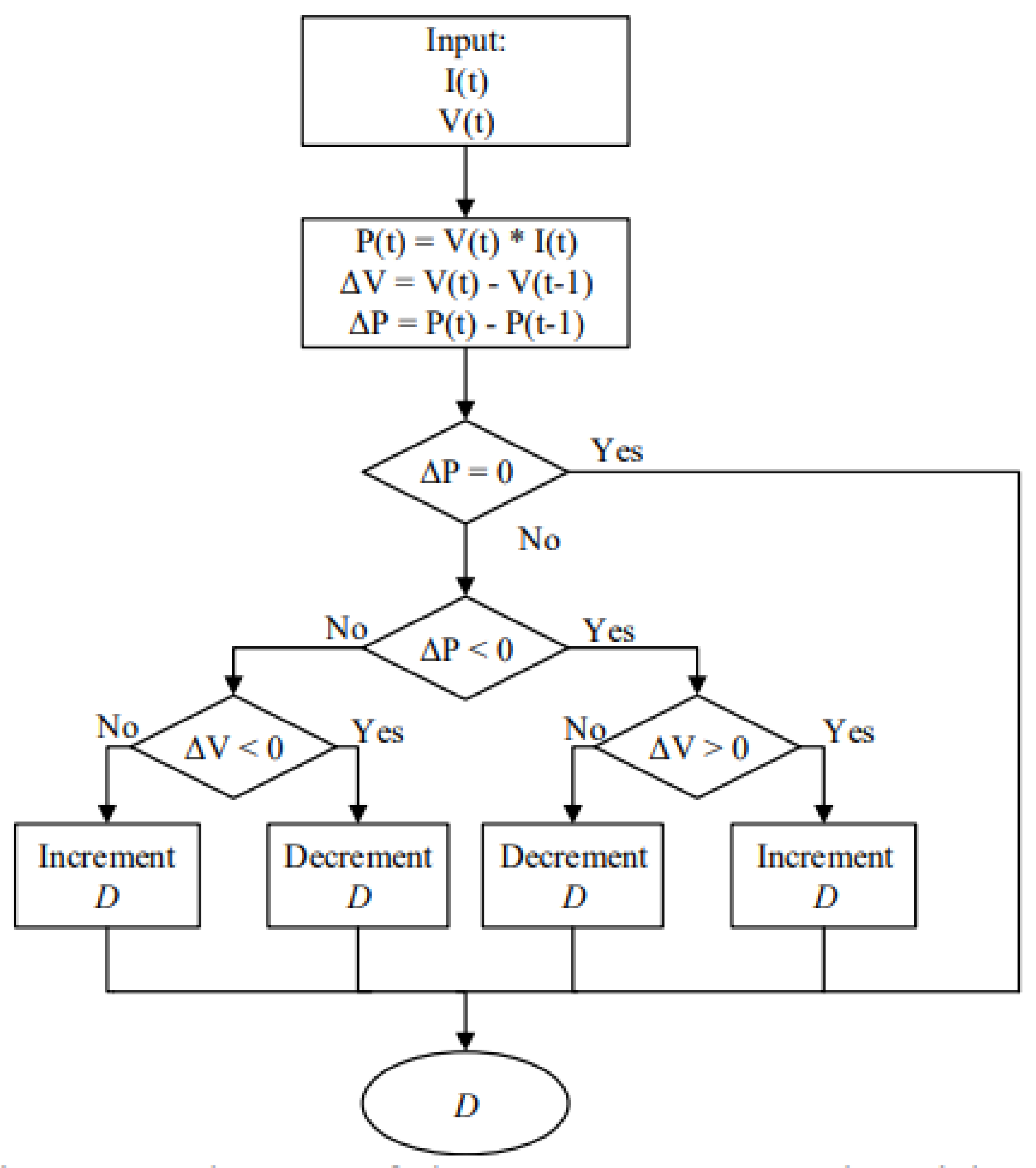




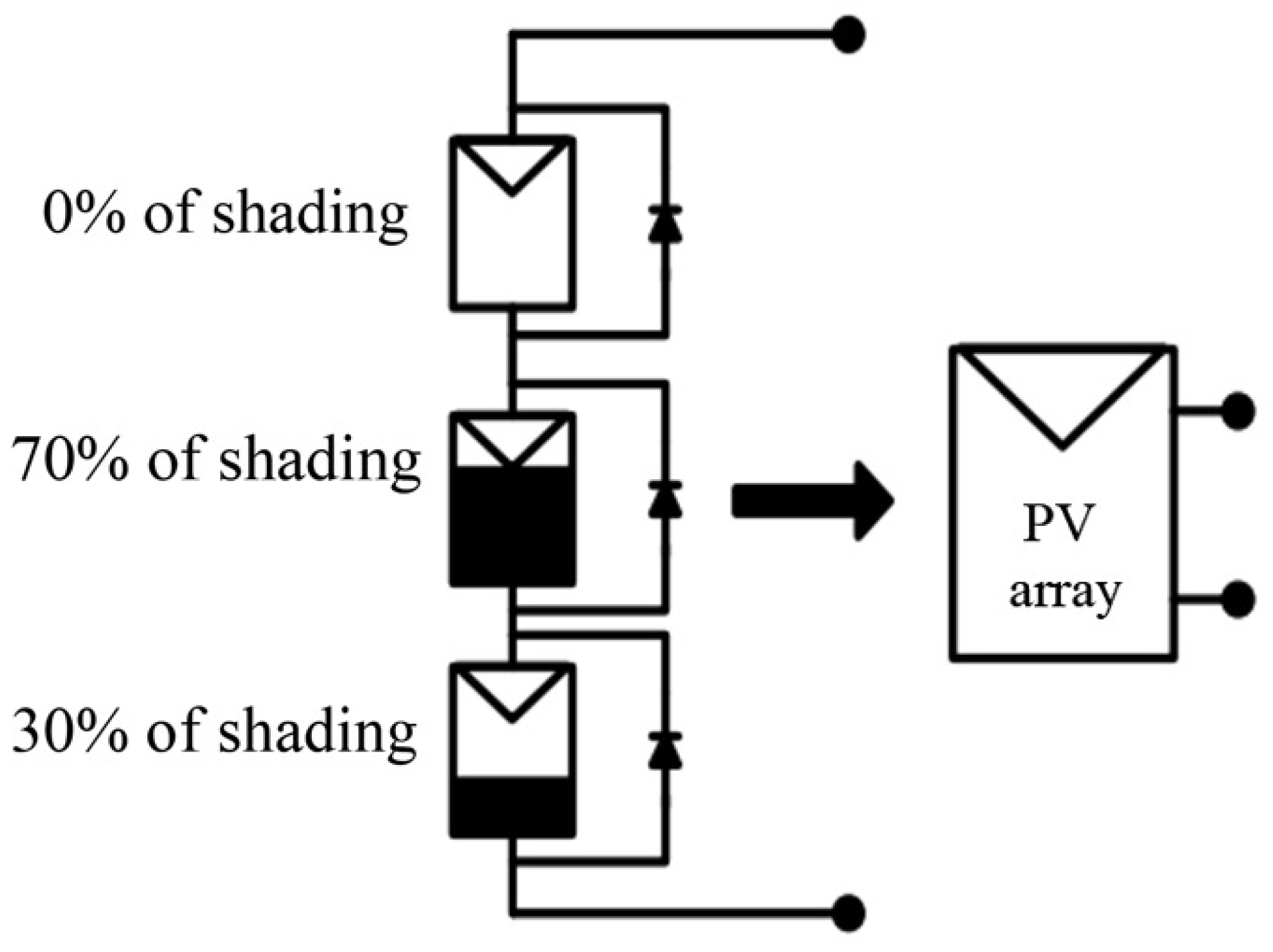



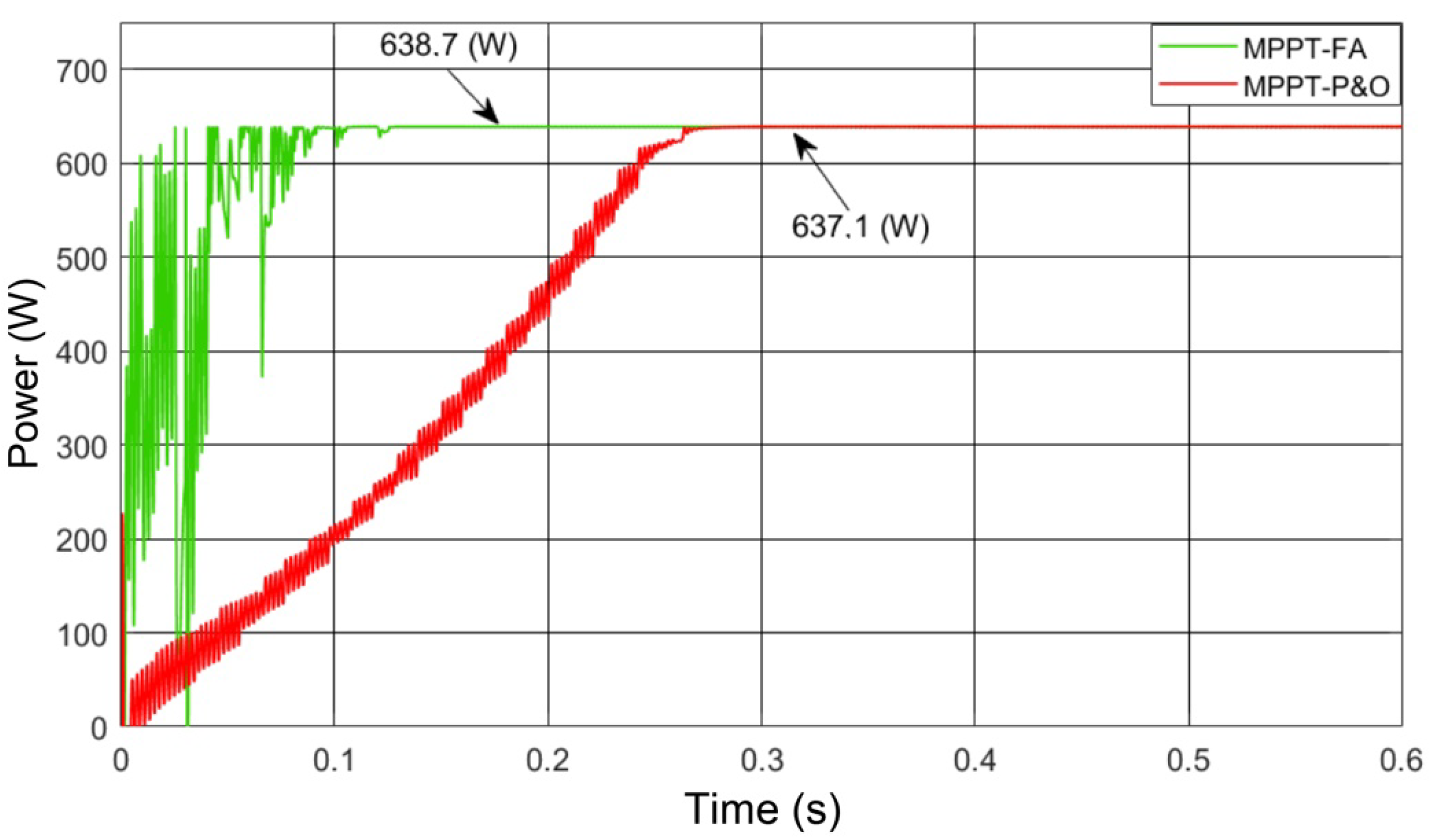
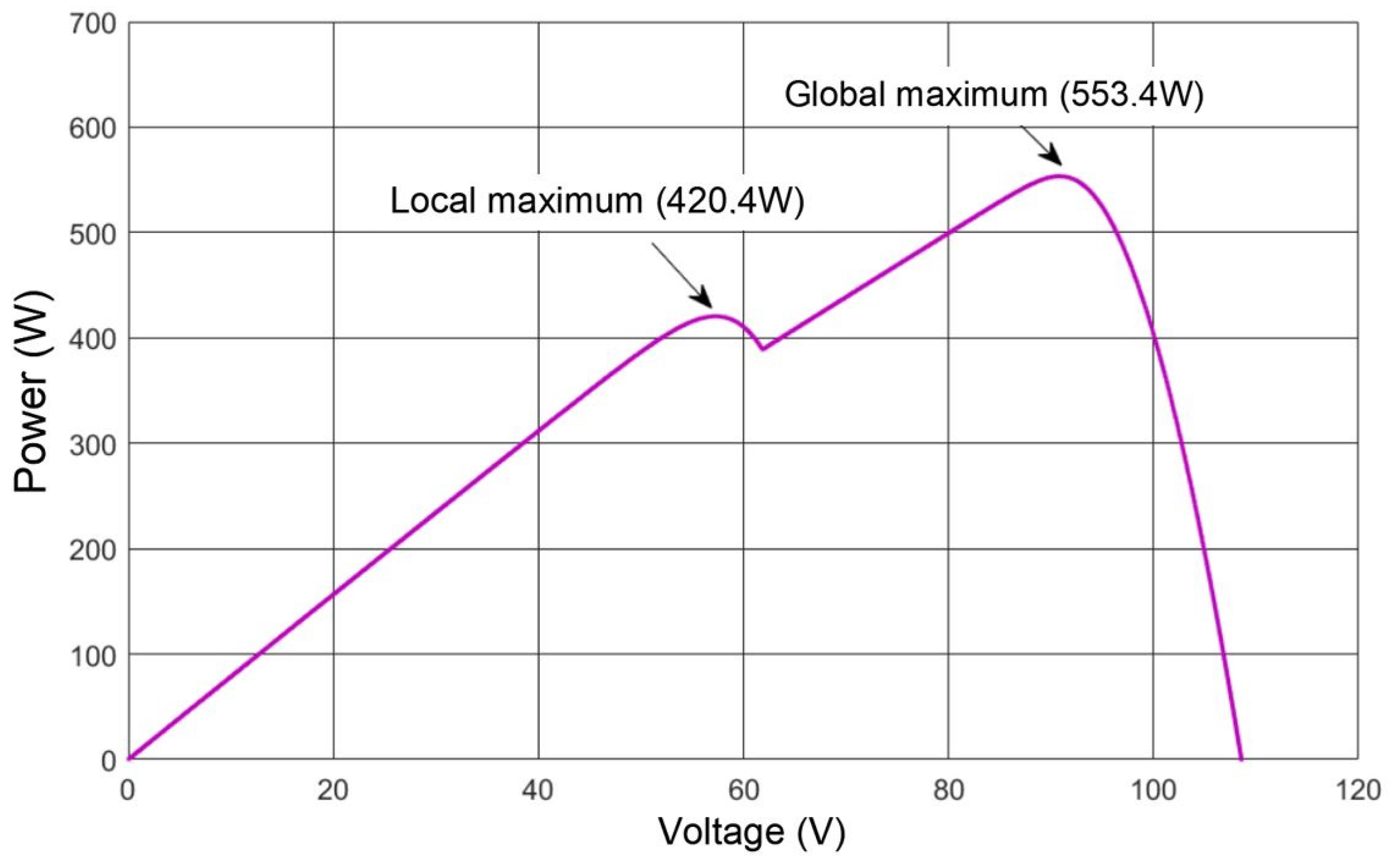


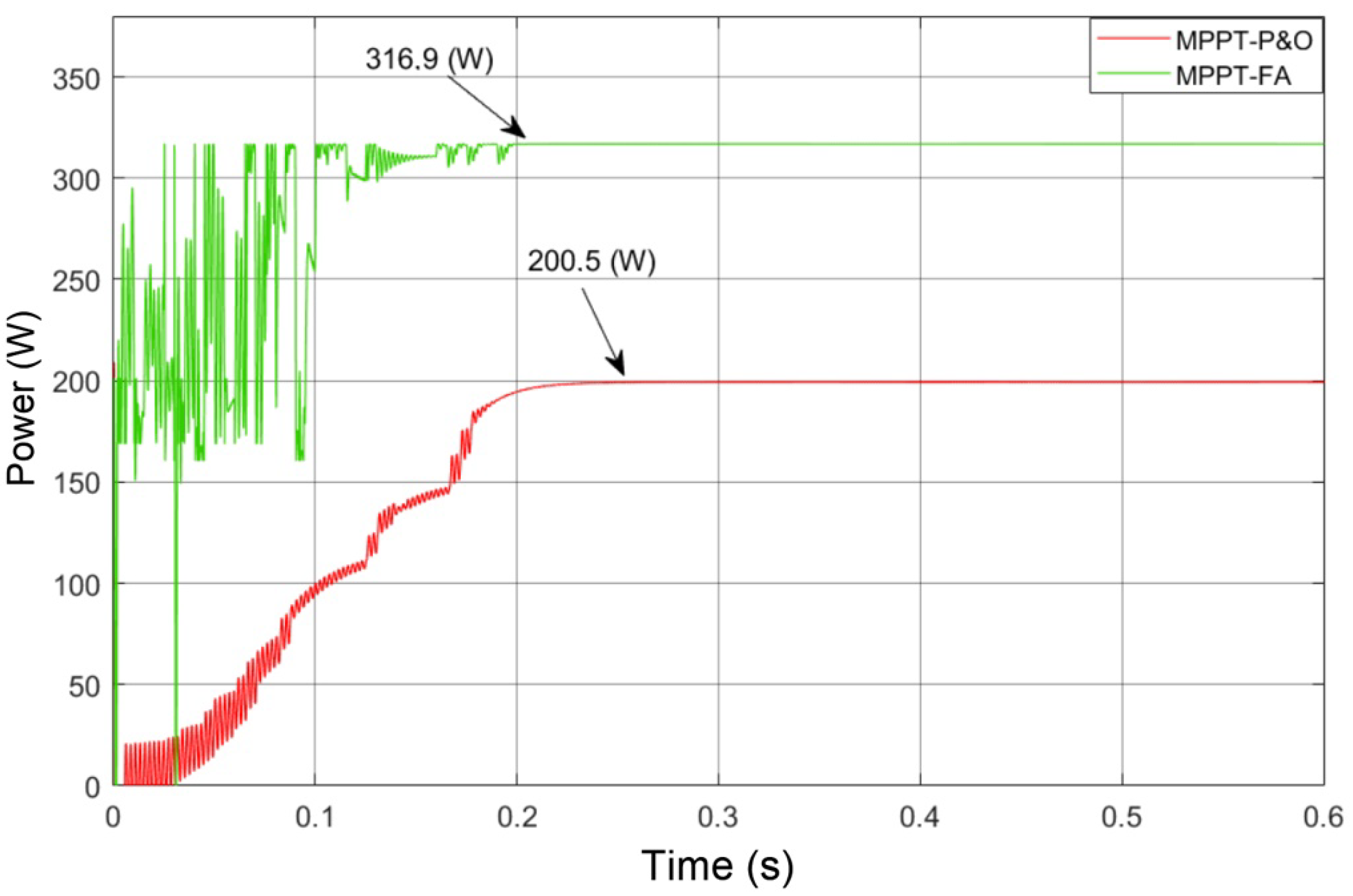
| Parameter | Value |
|---|---|
| Photovoltaic module model | 1 string with 3 panels 1 Soltech 1STH-215-P 639.45 W |
| Input current MPP | 7.3 A |
| Boost converter output voltage | 250 V |
| Dutty cycle (design) | 0.65 |
| Inductance | 1.282 mH |
| Capacitance | 100 μF |
| Capacitance | 286.6 μF |
| Load resistance | 97.75 Ω |
| Operation Conditions | Step 1 | Step 2 | Step 3 | |||
|---|---|---|---|---|---|---|
| Implemented Method | P&O | FA | P&O | FA | P&O | FA |
| Range time MPP [s] | 0.31 | 0.18 | 0.29 | 0.22 | 0.24 | 0.21 |
| Maximum power [W] | 637.1 | 638.7 | 419.4 | 553.1 | 200.5 | 316.9 |
| Method efficiency [%] | 99.63 | 99.89 | 75.78 | 99.94 | 63.22 | 99.93 |
| Power variation [ΔW] | 4.8 | 0.14 | 0.7 | 0.14 | 0.9 | 0.1 |
| Ref. | Method | Algorithm Compared with | Contribuition |
|---|---|---|---|
| [18] | FA | PSO and P&O | FA presented a more efficiency and very fast speed compared to the algorithms PSO and P&O. |
| [21] | FA | PSO and P&O | FA outperform P&O on convergence time and maximum power, PSO on convergence time. |
| [22] | MFA | P&O and FA | The modifications on MFA resulted in a great improvement in all compared parameters. The reduce number of fireflies it’s the primary responsible for improving. |
| [23] | FA | PSO and P&O | FA outperform P&O and had relatively equal efficiency to PSO due to FA receive few adaptation. |
| [24] | FA | No compared | Efficient for generation estimations of high-power PV systems. Capability of parameter extraction without any prior knowledge about variables of system. |
| [25] | OFA | FA and P&O | OFA outperform P&O and FA, the OBL technique accelerates the tracking process of FA calculating the fittest solution from initial population of fireflies. |
| [26] | IFA | FA | The main improvements of IFA compared to FA is the great reduce convergence time and the steps of iterations. |
| [27] | FA+GA | P&O, ABC, Cuckoo, FPA, FA and GA | Considering all parameters, FA + GA performs better than all algorithms presents. |
| [28] | FA | N-R, OS, GA and SA | FA outperforms the compared algorithms for the parameter extraction errors. |
| [29] | FLC-FA | P&O and FLC | FLC-FA outperform P&O and FLC. The method proposed presents a high efficiency and accuracy when the irradiation changing fast. |
Publisher’s Note: MDPI stays neutral with regard to jurisdictional claims in published maps and institutional affiliations. |
© 2022 by the authors. Licensee MDPI, Basel, Switzerland. This article is an open access article distributed under the terms and conditions of the Creative Commons Attribution (CC BY) license (https://creativecommons.org/licenses/by/4.0/).
Share and Cite
Watanabe, R.B.; Ando Junior, O.H.; Leandro, P.G.M.; Salvadori, F.; Beck, M.F.; Pereira, K.; Brandt, M.H.M.; de Oliveira, F.M. Implementation of the Bio-Inspired Metaheuristic Firefly Algorithm (FA) Applied to Maximum Power Point Tracking of Photovoltaic Systems. Energies 2022, 15, 5338. https://doi.org/10.3390/en15155338
Watanabe RB, Ando Junior OH, Leandro PGM, Salvadori F, Beck MF, Pereira K, Brandt MHM, de Oliveira FM. Implementation of the Bio-Inspired Metaheuristic Firefly Algorithm (FA) Applied to Maximum Power Point Tracking of Photovoltaic Systems. Energies. 2022; 15(15):5338. https://doi.org/10.3390/en15155338
Chicago/Turabian StyleWatanabe, Rodrigo Bairros, Oswaldo Hideo Ando Junior, Paulo Gabriel Martins Leandro, Fabiano Salvadori, Marlon Felipe Beck, Katiane Pereira, Marcelo Henrique Manzque Brandt, and Fernando Marcos de Oliveira. 2022. "Implementation of the Bio-Inspired Metaheuristic Firefly Algorithm (FA) Applied to Maximum Power Point Tracking of Photovoltaic Systems" Energies 15, no. 15: 5338. https://doi.org/10.3390/en15155338
APA StyleWatanabe, R. B., Ando Junior, O. H., Leandro, P. G. M., Salvadori, F., Beck, M. F., Pereira, K., Brandt, M. H. M., & de Oliveira, F. M. (2022). Implementation of the Bio-Inspired Metaheuristic Firefly Algorithm (FA) Applied to Maximum Power Point Tracking of Photovoltaic Systems. Energies, 15(15), 5338. https://doi.org/10.3390/en15155338








